Insiders Share Story Behind Arctic Cat 858 Engine
Each new season of Snow Goer magazine kicks off with a Q&A with top engineers and designers, taking readers much deeper into the new technology than they will see anywhere else. The story below was published in the October 2024 issue of Snow Goer. (If you were a subscriber, you would have seen this a year ago!). As we conduct this year’s interviews on 2026 technology, here’s a look at last year’s story on the then-new Arctic Cat 858 twin-cylinder two-stroke.
Tech In Focus 2025: Inside Arctic Cat’s New 858 Twin
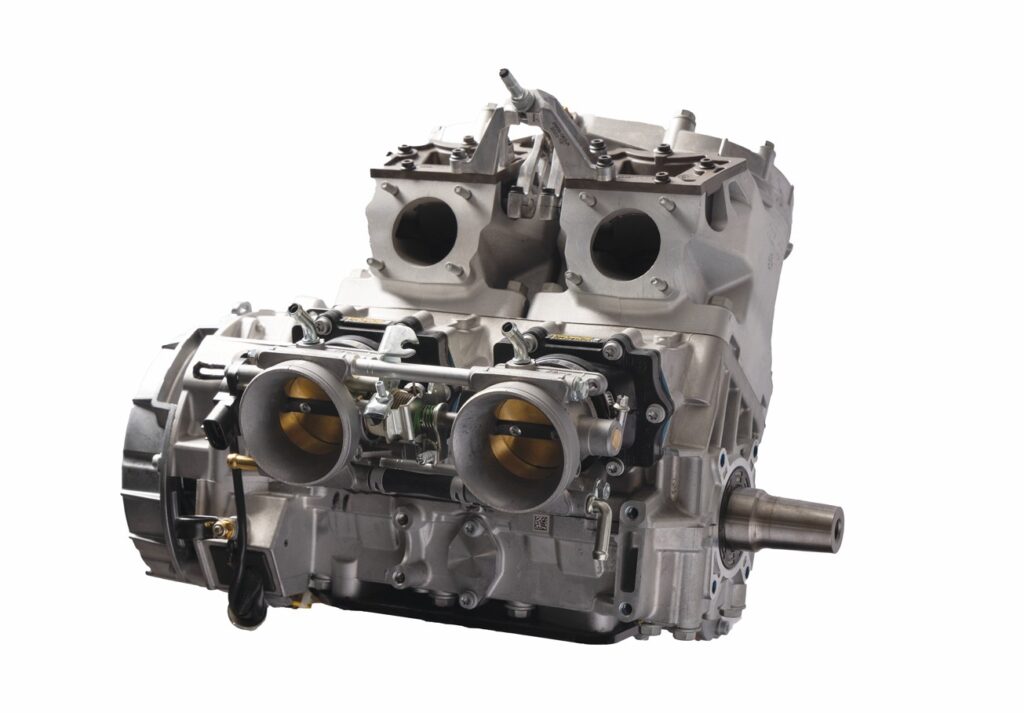
A year ago, Arctic Cat, its dealers and even media clowns like us proclaimed “the wait is over” for the brand’s long-awaited next big step when the Catalyst chassis was released. And now, after a year on the snow, all of the above are still crowing about the thrillingly lightweight and agile new platform.
For the bulk of snowmobilers who prefer more than 130 horsepower on tap at their thumb, however, the Catalyst announcement was a somewhat empty tease. Some folks bought a 600 ZR, Riot or M, but others dragged their booted feet in anticipation of a high-output engine in the new chassis.
That wait is now over as well. Arctic Cat unveiled a new 858 at the Hay Days Grass Drag event last September, promising it was a lightweight, quick-hitting, strong pulling high-tech marvel that would wow customers. The engine lived up to those promises when we tested pre-production 2025 models in February and March.
To learn more, we asked for an interview with a leader in the engine’s development. When we arrived, we were joined by a cast of nine team members who shared details on the new engine and its path to finalization. With so many speakers, we’ll identify those who shared important quotes as we go along.
SNOW GOER: How long has this particular engine been in development?
ALEX FUHRMAN: calibration and development engineer: “There were a lot of different iterations and conceptual designs of this engine, but we really started picking a direction and sticking with it in 2019.”
SG: What were the early goals or targets? And did you know right away that it would be launched in a new chassis?
FUHRMAN: “Some of the basic goals were, we are always looking for increased power – it is powersports, it’s the name of the game! Improved emissions: We always want to get that down a little further, everybody benefits from that. Refined run quality: That refined run quality that consumers are now craving is something that we strived for. And then always, mitigating weight, because power-to-weight is key, especially in the mountain market. And yes, it was always destined for a new chassis.”
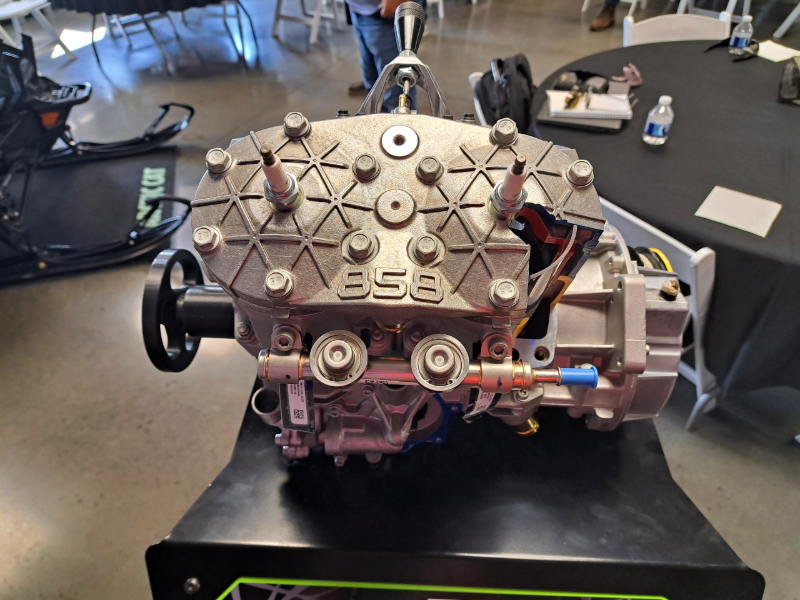
TROY HALVORSON, Arctic Cat director of product strategy: “Usually in the beginning of a project, we’ll go through what a project’s scope is, and we’ll put key metrics on there that we want. Some are goals and others are targets – or wants and needs. Things like emissions or the sound level of a complete vehicle, those are requirements. And then we have goals. As Alex said, anytime you do a new engine, there should be reasons why you’re doing it because it takes a lot of time and money to develop it. Power, as he said, is very big in our market – it’s a fun product so it needs to be a fun engine. But there are more boring things that a consumer maybe doesn’t completely care about but we care about as a business, like the emissions side of it. On top of that, going back to balancing the weight of the engine, it can’t be too heavy, it can’t be too big, it needs to fit into a package like the Catalyst. The new engine has to complement the Catalyst, which is lighter, easier to handle, maneuverable, easy to service and all of that stuff.”
SG: Was it always going to be a lay-down design or were other designs toyed with? Why was being low and deep in the chassis so important?
FUHRMAN: “There were other designs considered, but we always went back to our laydown design. It’s kind of what we are known for – it’s our architecture. The reasoning of getting that engine down low is to keep the CG [center of gravity] low. That gives the user more input into the vehicle, where the user’s placement can affect the direction of the vehicle easier. It went hand-in-hand with the chassis design.”
HALVORSON: “When it comes to laydown versus having a more ‘standup’ or conventional motor, we probably answered that question a while ago when we developed things all the way back to the Twin Spar and the ProCross [chassis]. There have been discussions of whether we go back to a standup engine because there are some things with those packages that could have some plusses. But at the end of the day, to get the engine down as low as possible, the only way you can do that is as a laydown, where the intake and exhaust are out the front and you can get it as close to the rider and down as low in the machine as possible. From a packaging standpoint, truly the laydown engine gives us everything we need to get it down where it needs to be.”
BEN LANGAAS, Arctic Cat engineering manager for trail, crossover and race product: “I think another important point to note is that we had to forward-think about potential engine packages that we already had, like the 600. Sharing that same laydown technology allows us to share common airboxes and drive train components and placements. So that weighed into it as well.”
ANDY BEAVIS, Arctic Cat engineering manager for mountain: “And from the chassis side, when we do those layouts, this was a really good opportunity for the engine group, the powertrain group and the final vehicle groups to work together on a ground-up [project] with the chassis and an engine at the same time. We don’t always have that luxury. But when we start with the engine in the chassis and the rider and then heavy parts like fuel, the engine drives a lot of the design. You know, the engine is the bottom part and everything else stacks on top of it. So, having the engine as low as possible is very key to the total package that we wanted.”
SG: When you say the groups worked together, how much direct or regular contact is there?
BEAVIS: “We’re all working concurrently on the same computer system in building the model virtually. So, there is a lot of back-and-forth between the engine layout design guys and the chassis layout design guys. Multiple times a day, especially early-on, we’re having conversations and talking about the compromises of, for example, a bigger cylinder bore or different changes to an engine layout – intake and exhaust and things, and how that could [cause a] domino effect into all of the different parts of the chassis. A lot of design work is working out the compromises early on the core components and getting them placed in the vehicle. Then some of the smaller, different parts come in later on. I mean, we can fit in an oil tank a little bit better than we can fit in a fuel tank or an engine. Some of the key drivers for the engine requirements of pipe layout and pipe shape and design, those kind of have to be figured out fairly early and then other parts fit in around it.”
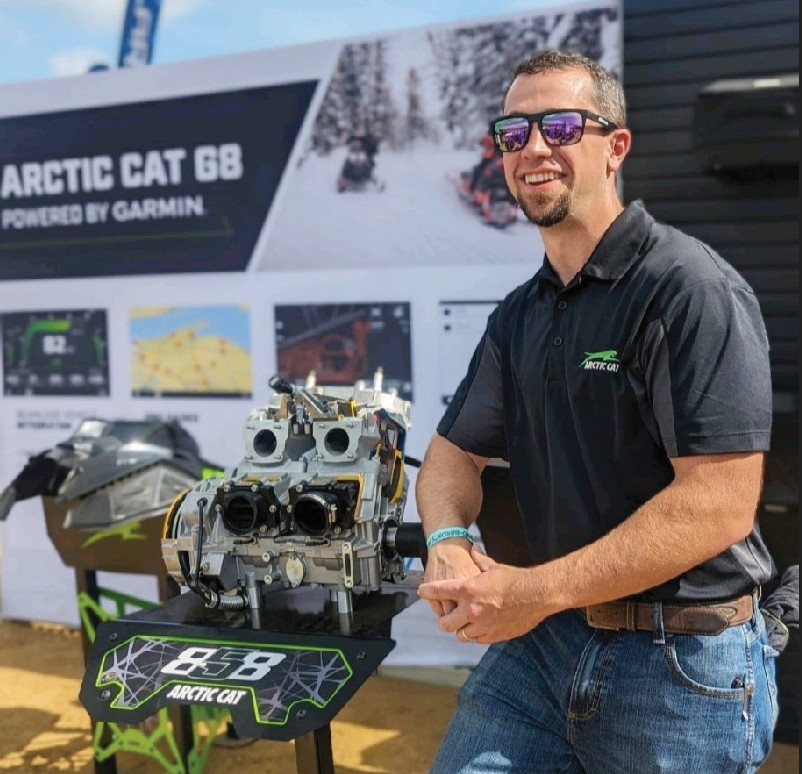
SG: What factors were involved in deciding to keep the 85mm bore of your 800 twin but expand the stroke to 75.6, or even landing on the 858cc displacement?
FUHRMAN: “We had 21 different design iterations that we analytically looked at to meet our power targets. Then we took into consideration requirements from product strategy like emissions targets that we had to meet. We knew we didn’t want to increase our cylinder bore due to combustion efficiency and detonation tolerance. So that kind of pushed us into stroking the engine out further to meet that given power target. But we had endless combinations. Also, we didn’t want to increase the bore because that would push the engine to be wider. That was another huge one: to keep the engine width as minimal as possible.”
SG: Give examples of places where weight loss was possible without hurting durability, and how such decisions are made.
FUHRMAN: “From that perspective, Beavis was asking about every part [laughs]. Every piece was asked if it could be lighter – bolts, exhaust servos, any part that was out there it was asked if it could be lighter.”
BRAD MAUCH, Arctic Cat director of engineering for the powertrain group: “Specific to the engine, the crankcase was very much optimized, FEA-wise [using finite element analysis]. We’re looking at maintaining durability but anywhere the FEA showed we could put holes in parts or minimize the aluminum, we did, but we still had to meet the stress and durability requirements. Engine mounts were another example; they were integrated into the crankcase, which allowed for less parts and optimal weight saving.”
HALVORSON: “This engine was designed with the Catalyst. So, in previous models and platforms that we’ve had, we’ve had engine designs that have spanned different platforms. For example, our current 600 had some bosses cast into the crankcase that we maybe didn’t even need to use in the ProCross. Now, when you design a new engine, we can get rid of those bosses because they were not needed for the new Catalysts. So it just makes it more specific to that mount.”
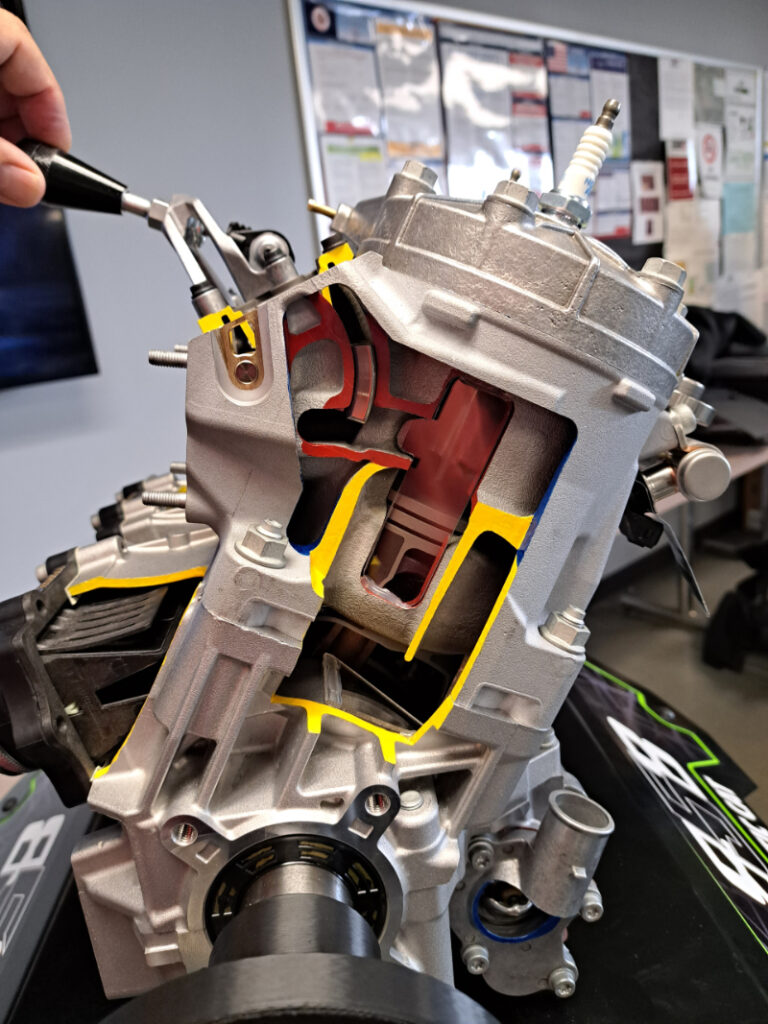
SG: One notable area of weight savings was the patented new design of your variable exhaust system. Tell us how the system works, from its efficiency to how it has more port size change, and beyond.
FUHRMAN: “We got weight out of it through reduced part count – it has 15 fewer parts per cylinder with the exhaust valve design itself. We’re getting the performance we need by getting the valve closer to the piston. The distance there makes it a more effective timing edge, which increases our performance, reduces our emissions – everything benefits from that effective timing edge at all of our positions that we have. With that, we are able to make a larger change from valve-down to valve-up, and that gets us a bigger and wider torque powerband. It gets us more efficiency and run quality at low speed but gives the customer all of the high-end power that they want and need to make it exhilarating. The design itself just allows us so much flexibility that previous designs didn’t have. And, it’s lighter, so it checked all of the boxes.”
SG: When talking about shaving that many parts from the exhaust valve system, was the goal right up front to make it both simpler and more effective?
FUHRMAN: “Yeah, it came to that. When we started out, a lot of the original research for this engine was done on our 400 [single-cylinder found in Blast models] as a combustion modeling engine. We found we needed a little larger and wider range in port area to achieve our targets and we couldn’t do that with our guillotine system. And we kind of already knew the way our slide valve system was, we wanted to improve the part count. We were already looking at designs to improve the part count, and then with the area change that we wanted to do, that pushed us into that. It ended up being a win on all fronts.”
SG: What’s another example on this Arctic Cat engine package of shaving weight while not hurting durability?
FUHRMAN: “The exhaust system is another area where we dropped some weight. The system for the 858 is all stainless steel, which allowed it to be thinner and lighter. We really didn’t leave anything that wasn’t examined.”
SG: Many snowmobilers understand an engine being developed around horsepower, weight and durability targets. But of the many other parameters – from fuel or oil efficiency to emissions, sound level, packaging, etc. – which targets were particularly challenging to meet?
LANGAAS: “Outside of the engine, we had to factor in under-hood heat management quite a bit. I know Jeff [Tweet] and his calibration team did a pretty extensive effort on that a couple of winters ago, just studying the impact with that bigger horsepower engine and the bigger pipe that takes up more space and is closer to the fuel tank and closer to the plastics. How do we get rid of the heat? There’s a lot of effort on that, studying how we get the air into the hood, and get it out. There were a couple of pretty unique tests that were done where we were able to do that and repeat that study pretty repeatedly, given the fair-to-worse conditions in late spring testing.”
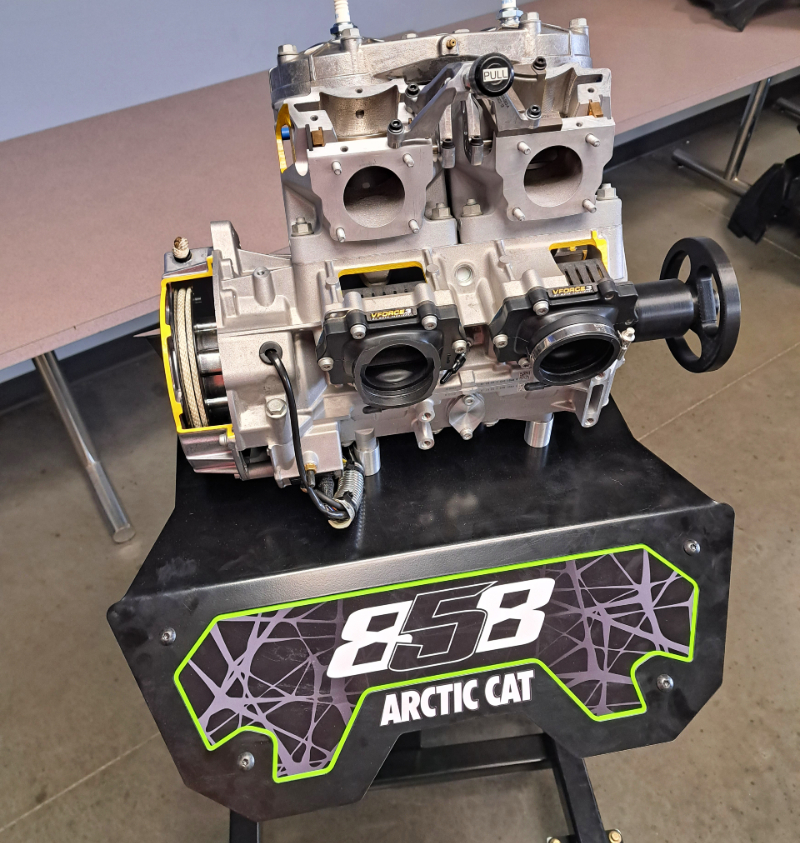
SG: Models with the new 858 engine feature the Catalyst’s final belt drive system. Did that affect its development, or was the belt drive far enough down the driveline to not affect the 858’s timeline?
LANGAAS: “We did a lot of the durability testing on the final drive with higher horsepower engine packages originally, just to make sure that we’re going to withstand when we get the big engine in there. So, it’s nice that we can use all of the same parts, components and belts for the 600 as well as the 858, which makes sense. So, the driveline portion of this vehicle, when it came to the 858, went relatively smoothly. Probably the biggest hurdle we had was getting the engine mounting to the place where we were happy with the durability and vibration levels. Obviously if you have a higher-stroked engine we were going to have a little more vibration to work with, but we worked as a team and combat that. Between field testing and chassis durability dyno tests, we were able to come up with a pretty robust package that meets expectations.”
SG: For Joe or Jane 800-class Arctic Cat rider who has now ordered the 858 in the Catalyst, where are they going to feel the biggest difference?
LANGAAS: “The biggest notice that I feel riding the 858 is the smoothness of the power from mid throttle to wide open. It just keeps going, and the run quality down low I think is far, far improved compared to our 800. I’m not putting the 800 down, but it’s really improved down low [on the 858], even in that low, trail-idling speed it’s a lot more consistent. It’s more linear through the whole shebang. It’s quite a package.”
BEAVIS: “I’d agree. From the mountain side, it’s all about the details because you’re riding in really technical situations. So, the driving ideas behind the Catalyst and low CG and given that your body is a major factor into how the vehicle reacts, that all makes the vehicle react so much easier. Yes, the power is awesome when you need it and it’s incredible when you point it up a hill, but the vehicle is so easy to manage and get through situations that someone maybe would have struggled with before. Spending three years on [finalizing] the 600 and then jumping on the new 858s, it just adds excitement to it. It’s the same feel. It’s easy to handle, it’s lighter than the 600, but when you want that power, it’s right there. It makes the whole package something to be excited about.”
SG: Is there any other system that was vital to the development of this engine package that you’d like to touch on?
FUHRMAN: “One thing would be our new VForce reed. It’s got a unique pedal design to the 858, which is something most people don’t know about. It really gave us improved performance and durability, which is huge. It’s kind of an unsung hero of the project because it just performs so well the whole time that people forget about it. The weave in the pedal is a unique weave that they [Moto Tassinari] had been working on. It was an awesome improvement for our engine.”

SG: The engine that resulted in all of this impressed our team! Now that the 858 in the Catalyst platform is done, what about this project makes you and your team most proud?
MAUCH: “One of the things that we’ve talked about is how we met the goals we set out to meet while maintaining our durability. We were actually able to drop a couple of pounds off the engine over the 800.”
BEAVIS: “From my side, the biggest one was that we surprised people with the 600 and then there was a lot of expectation on the 858. And, to Brad’s point, the 858 in the vehicle is below the weight of the 600. So, I think that’s a home run from a total vehicle standpoint. It speaks to the benefits of doing a ground-up engine – a bigger engine with a longer stroke, yet it’s lighter than the last-gen 600 engine that we had in that package. Then, beyond that, everybody on the team is a pretty dedicated, passionate snowmobiler and we’ve been riding this thing for four or five years. But as more and more people got on it as the project went along, they would tell you how incredible it is. That’s kind of the payback.”
LANGAAS: “We’re a very small team compared to past projects, and you see all of the collaboration and cross-functional work done by our groups. We get spread thin and there’s some overlap in the drivetrain groups working with us suspension guys, and engine guys working with chassis guys. We’ve got engineers out doing durability riding to get seat time. I think it’s been cool to see that all unfold and to be a part of it.”
Editor’s Note: Every Snow Goer issue includes in-depth sled reports and comparisons, aftermarket gear and accessories reviews, riding destination articles, do-it-yourself repair information, snowmobile technology and more. Subscribe to Snow Goer now to receive print and/or digital issues.


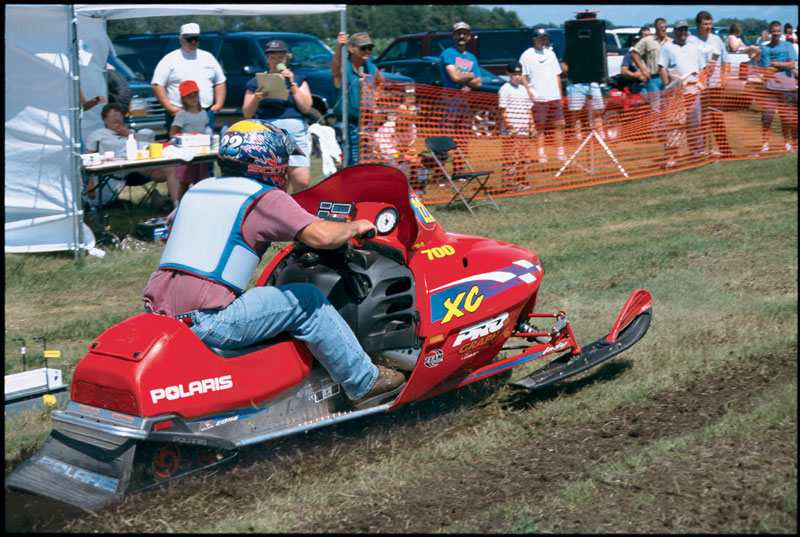

Arctic Cat has to move ahead full steam so Hay Days will likely see the release of several upcoming models:
1. XC and SX race sleds for the current season
2. Turbo 858
3. ZR 700 to replace the 600 and celebrate the 29th anniversary of the F7 700 engine that had 140 hp and beat many of the competitions 800 sleds.
The Turbo 858 and ZR 700 have a great chance of early MY 27 release in January as AC MY26 had few sales due to fact Textron was selling the brand and thus had no MY26 release. So buyers of MY26 will not be too upset. AC will follow Polaris long history or early releases such as 1992 first XLT and 1990 first RXL650 and 1996 early release of XC 700 then XC 600 a few weeks later.
Perhaps Hay Days will also reveal Arctic Cat 4 stroke engine in the Catalyst chassis perhaps a 130-150 hp plus a turbo with 220+ hp and a 80-120 hp sled (either 2 or 4 stroke) to fill in the large gap in hp line up between the 600 (soon to be 700) and the 858 (which may soon to into a 900).